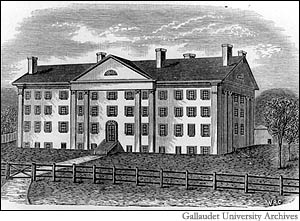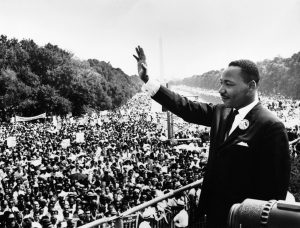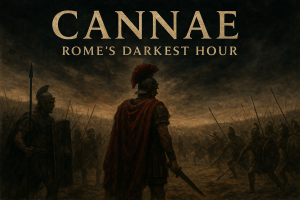During the 1800s, deaf people in America had no language they could use to communicate with other deaf people, or anyone else for that matter. They let others know their needs and wants through gestures and signs they came up with on their own. Some basic gestures, such as “yes” or “hungry,” were somewhat universal, but those signs only scratched the surface of what deaf people wanted to say. They were in need of their own language and of a way and a place to learn it, and although he was not deaf or hard of hearing, a man named Thomas Hopkins Gallaudet was the one who finally acquired it for them.
Thomas Gallaudet was a man of many talents. After graduating from Yale at seventeen, he worked as a law assistant and a tutor, but due to health-related issues, he left his job and became a door-to-door salesman in rural Kentucky and Ohio, where he schooled young children that couldn’t afford an education. He especially enjoyed teaching geography, U.S. history, and the Bible, which eventually lead to him discovering his own passion for religion. He earned his license to be a preacher, and became a traveling minister, going everywhere he felt there was a need. His constant traveling allowed him to visit his family in his hometown of Hartford, Connecticut on a regular basis.1

During one of his visits home, Gallaudet came across his neighbor’s daughter, Alice Cogswell, playing by herself. At the age of two, Alice had contracted meningitis, and as a result, lost her hearing.2 Her father, Dr. Mason Fitch Cogswell, explained to Gallaudet that his daughter was deaf and that she had trouble communicating with not only other children but also with her own family. Knowing that Gallaudet was a teacher, Dr. Cogswell pleaded with Gallaudet to help Alice learn how to speak, regardless of whether it was with her voice or her hands.3
Gallaudet agreed, and started teaching a simple form of sign language as best as he could. Nevertheless, both Gallaudet and Dr. Cogswell were deeply concerned with the lack of deaf education in America and set out to change that. The two them collected donations and support from their community, and soon enough, they had sufficient funds to send Gallaudet to Europe, to track down a sign language teacher.4
During his travels, Gallaudet came across an advertisement for a speech given by Abbe Sicard, the principal of a deaf institution in Paris, France. Gallaudet had previously known about him and his work, so he attended one of his speeches. After the speech, Gallaudet approached Sicard, and spoke to him about his troubles and worries over deaf education in America. Sicard listened intently to his woes and made the decision to invited Gallaudet to the institution he taught at, to take lessons under him. Gallaudet zealously accepted the offer, and went off to Paris with Sicard.5
In addition to taking classes with Sicard, Gallaudet also took private lessons with Sicard’s chief assistant, Laurent Clerc. Gallaudet was entranced by Clerc’s expertise in the sign language and begged him to come to America to teach with him. Clerc was skeptical, but Gallaudet was adamant. He worked hard to get Clerc onboard with his plan. Clerc eventually gave in and sought permission from Sicard to take a leave for his journey to America. Sicard was also initially wary of Clerc’s expedition, but also came around to the idea and granted Clerc the permission he asked for.6

On June 18, 1816, Gallaudet and Clerc set out for Hartford, Connecticut on the ship Mary Augusta, a journey that lasted fifty-two days. The two men used that time to exchange their knowledge of languages. Clerc continued teaching Gallaudet the vast array of signs that were included in French Sign Language, and Gallaudet helped Clerc to polish his English-speaking skills. On August 22, 1816, the day the Mary Augusta arrived in America, Laurent Clerc met Alice Cogswell for the first time. Although she did not know French Sign Language, Clerc “communicated with her through sign associations.” Clerc saw Alice had a strong will to continue to learn sign language, which fueled him in his quest to teach the deaf people of America a standardized nonverbal form of communication.7
Over the next couple of months, Gallaudet and Clerc traveled the United States. They spread information about sign language and deaf culture, met with potential students and their parents, and they began the process of establishing the first deaf school in America. They collected funds by taking donations from the public and from the Connecticut General Assembly also. They raised over $15,000 and they used that money to start what was “originally called the Connecticut Asylum at Hartford for the Instruction of Deaf and Dumb Persons (now the American School for the Deaf).”8 On the day of April 15, 1817, a little less than a year since Gallaudet brought Clerc to the United States, the school opened its doors to the public. Laurent Clerc was the first teacher and Alice Cogswell was the first student. The French Sign Language Clerc taught to his students eventually evolved to the dialect that deaf Americans still use today, American Sign Language.9

Although the school was good, Gallaudet and Clerc wanted to keep going. They went to Congress and got approval from the House of Representatives, Senate, and President Abraham Lincoln to granted college degrees from their school. Eventually, the American School for the Deaf branched out to form Gallaudet University, the first and only all-deaf university in the United States.10 Both the American School for the Deaf and Gallaudet University continue to provide proper education to those who are deaf and hard of hearing, proving a saying that prevails in deaf culture: Deaf people can do EVERYTHING a hearing person can do except hear.
- Katalin Enders, “Gallaudet, Thomas Hopkins,” 2003, Learning to Give (website), https://www.learningtogive.org/resources/gallaudet-thomas-hopkins. ↵
- “Alice Cogswell,” Scholastic. April/May 2012. ↵
- Carolyn Ball, The History of American Sign Language Interpreting Education (Minnesota: Capella University, 2007), 11. ↵
- Loida R. Canlas, “Laurent Clerc: Apostle to the Deaf People of the New World,” 2015, Gallaudet (website), http://www3.gallaudet.edu/clerc-center/info-to-go/deaf-culture/laurent-clerc.html. ↵
- Margret A. Winzer, The History of Special Education: From Isolation to Integration (Washington D.C.: Gallaudet University Press, 1993), 101. ↵
- Margret A. Winzer, The History of Special Education: From Isolation to Integration (Washington D.C.: Gallaudet University Press, 1993), 101. ↵
- Loida R. Canlas, “Laurent Clerc: Apostle to the Deaf People of the New World,” 2015, Gallaudet (website), http://www3.gallaudet.edu/clerc-center/info-to-go/deaf-culture/laurent-clerc.html. ↵
- Loida R. Canlas, “Laurent Clerc: Apostle to the Deaf People of the New World,” 2015, Gallaudet (website), http://www3.gallaudet.edu/clerc-center/info-to-go/deaf-culture/laurent-clerc.html. ↵
- Marc Marschark and Patricia E. Spencer, Oxford Handbook of Deaf Studies, Language, and Education (Oxford: Oxford University Press, 2003), 13-14. ↵
- Loida R. Canlas, “Laurent Clerc: Apostle to the Deaf People of the New World,” 2015, Gallaudet (website), http://www3.gallaudet.edu/clerc-center/info-to-go/deaf-culture/laurent-clerc.html. ↵



61 comments
Roberto Rodriguez
One summer I had the privilege to volunteer and help disabled children, I remember filling out the application to become a volunteer and one question was “Do you know ASL”. My answer was “no”, but it kind of intrigued me, “Why don’t I know it?”. I felt like everyone should try to learn it (I’m still working on it myself), regardless I had no idea the story behind the development of ASL. I love this story mostly because it shows how people can come together and with enough determination, they can change the world forever. Though some might find the short length of this article to be a downside, I think the length was perfect. It gave me just enough information to keep me interested, while simultaneously giving me all of the highlights.
Thomas Fraire
Great article, I have always wondered where this language came from. I really love how this story was told and how Thomas Gallaudet tried to help deaf people continue to go to school and grow in the real world. Congrats on the nomination I enjoyed it because of how different it is than other articles on the site. This man was absolutely brilliant for innovating and pushing for the progress that he did.
Tyler Reynolds
I liked the article though it was short and could have been improved upon. This article reminds me of a middle school history teacher I had. The teacher would tell us all types of stories and liked to “preach the truth” to us. It was the combination of the difficulty in his class and his personality that made a majority of students hate him. One of the stories he talked about was about how normal people restrain ourselves when conversing with others:We won’t say certain things or even use cuss words/slurs. This, he explained, was not the case for a couple of deaf students he had in his class several years ago. When these deaf students were really upset with another person, they would make hand-signs in a furious speeds including all types of foul language that would no doubtly get other students in trouble if they were to utter the same words the translator interpreted.
Amariz Puerta
Sign language is such a big part of the language culture, I always thought about taking a class because it is becoming more and more popular. Thomas the creator of sign language must to have been super intelligent, without him we would not have been where we are today in the means of communication. Im compeletly inspired by his contribution to the deaf and hearing impaired community.
Diego Terrazas
This is a man who gave a voice to the deaf. Gallaudet essentially founded sign language and his hard work is seen today, giving deaf people a means to communicate with the rest of the world. Furthermore, this form of communication gave the deaf a means to live life like everybody else. Unfortunately, not everyone knows sign language which I think may be a little saddening when someone may not know what you are trying to say.
Christopher Hohman
Nice article. It is truly warm to read that these two men wanted to give deaf people a proper voice in their lives. It must not have been easy to leave France and all that you ever known for a strange land that you did not know, but one of these men did that because he truly believed in his cause. it is so great that the school they founded is still around today and helping deaf people receive a quality education.
Nadia Carrasco
Sign language has always interested me so I knew I would enjoy this article. I did not know that it was Thomas Gallaudet who ultimately created American Sign Language. He created such an impact on countless deaf and hearing-impaired citizens. Without American Sign Language the deaf impaired community would not have the means of communication and would not be able to live normally. Overall, great article !
Chelsea Alvarez
I have always been really fond of sign language. It was a really nice gesture for Thomas Gallaudet to open a school for the deaf, because he understood the importance of deaf people to have the opportunity to communicate with those around them. This article did a very well job of piecing together the timeline of him teaching simple signs to actually finding a way to create a learning environment for the deaf community.
Samantha Ruvalcaba
This is a well-written and informative article. I honestly didn’t know about a French sign language existence. I thought sign language was more or less universal–which I realize now is a foolish thought. What an amazing concept that Gaulladet put into fruition. Without American Sign Language, the deaf-hearing impaired community would not have a means of communication, but thanks to Gaulladet, Clerc and Sicard, they do.
Octaviano Huron
Very well-written article. Thomas Gallaudet can be considered the father of American Sign Language, and countless deaf and hearing-impaired citizens can thank him for his genius. I loved how this article ended with the fact that those who are deaf are just as capable in life as those who are not, and how Gallaudet University is working to continue the education of the deaf.